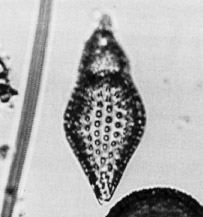 Phormocyrtis
striata striata Brandt
Phormocyrtis
striata striata Brandt Phormocyrtis
striata striata Brandt
Phormocyrtis
striata striata BrandtPhormocyrtis striata Brandt in Wetzel, 1935, p.55, pl.9, fig.12; Riedel and Sanfilippo, 1970, p.532, pl.10, fig.7
Phormocyrtis striata striata Brandt, Foreman, 1973, p.438, pl.7, figs.5-6, 9
P. striata striata is here limited to those forms having the abdomen circular in transverse section. Specimens observed agree well with those described by Riedel and Sanfilippo (1970). The collar stricture has four collar pores with a vertical pore emerging from the thoracic wall that envelopes the basal cephalis (Foreman, 1973).
Length (excluding horn) 170-255 µm; maximum breadth 70-100 µm (Sanfilippo et al., 1985).
Shell approximately spindle-shaped with the abdomen (circular in transverse section) forming the major part (Foreman, 1973).
P. s. striata is distinguished from its ancestor P. s. exquisita by having the abdomen circular in transverse section. It differs from Buryella clinata and Phormocyrtis turgida (Krasheninnikov, 1960, p.301, pl.3, fig.17) in the relatively larger abdomen and lack of a fourth segment (Sanfilippo et al., 1985).
This three-segmented form, with the fusiform abdomen constituting the major part of the shell, has its greatest width usually near the middle. Abdominal pores are circular, in longitudinal rows commonly separated by ridges. Termination ragged, toothed, or in rare specimens closed (Sanfilippo et al., 1985).
P. s. striata occurs widely in tropical late early to middle Eocene sequences, but in low abundances, and sporadically in the upper part of its range. Its evolutionary transition from Phormocyrtis striata exquisita is approximately synchronous with the lower limit of the Phormocyrtis striata striata Zone. Its morphotypic last appearance is approximately synchronous with the lower limit of the Podocyrtis chalara Zone.
Phormocyrtis s. striata arose from P. s. exquisita, and left no descendants.